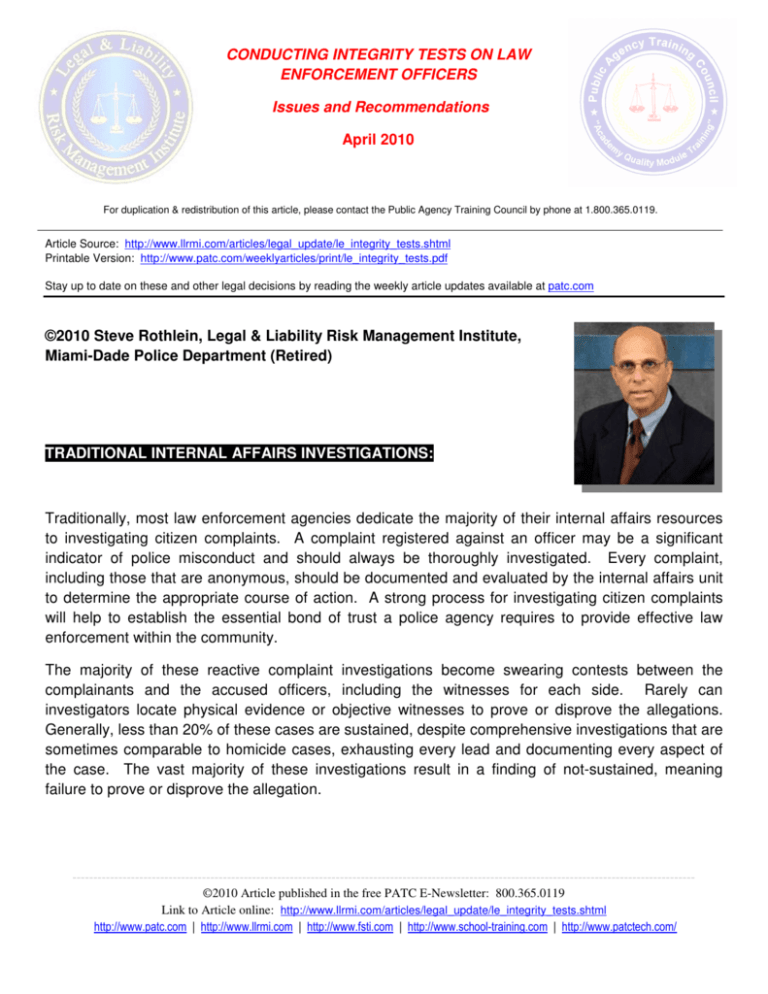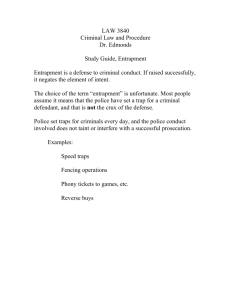Conducting Integrity Tests on Law Enforcement Officers
advertisement

CONDUCTING INTEGRITY TESTS ON LAW ENFORCEMENT OFFICERS Issues and Recommendations April 2010 For duplication & redistribution of this article, please contact the Public Agency Training Council by phone at 1.800.365.0119. Article Source: http://www.llrmi.com/articles/legal_update/le_integrity_tests.shtml Printable Version: http://www.patc.com/weeklyarticles/print/le_integrity_tests.pdf Stay up to date on these and other legal decisions by reading the weekly article updates available at patc.com ©2010 Steve Rothlein, Legal & Liability Risk Management Institute, Miami-Dade Police Department (Retired) TRADITIONAL INTERNAL AFFAIRS INVESTIGATIONS: Traditionally, most law enforcement agencies dedicate the majority of their internal affairs resources to investigating citizen complaints. A complaint registered against an officer may be a significant indicator of police misconduct and should always be thoroughly investigated. Every complaint, including those that are anonymous, should be documented and evaluated by the internal affairs unit to determine the appropriate course of action. A strong process for investigating citizen complaints will help to establish the essential bond of trust a police agency requires to provide effective law enforcement within the community. The majority of these reactive complaint investigations become swearing contests between the complainants and the accused officers, including the witnesses for each side. Rarely can investigators locate physical evidence or objective witnesses to prove or disprove the allegations. Generally, less than 20% of these cases are sustained, despite comprehensive investigations that are sometimes comparable to homicide cases, exhausting every lead and documenting every aspect of the case. The vast majority of these investigations result in a finding of not-sustained, meaning failure to prove or disprove the allegation. ----------------------------------------------------------------------------------------------------------------------------------------------------©2010 Article published in the free PATC E-Newsletter: 800.365.0119 Link to Article online: http://www.llrmi.com/articles/legal_update/le_integrity_tests.shtml http://www.patc.com | http://www.llrmi.com | http://www.fsti.com | http://www.school-training.com | http://www.patctech.com/ RANDOM INTEGRITY TESTING: Random integrity tests are designed to observe and evaluate an officer’s conduct in situations in which a specific set of circumstances has been created that requires police intervention. Several major police departments, including the Los Angeles Police Department (LAPD), the New York City Police Department (NYPD), and the New Orleans Police Department (NOPD) routinely conduct random integrity tests of their officers to determine if their conduct in handling their official duties is appropriate. There exist two schools of thought on this type of orchestrated integrity test. Many consider such action distasteful and unnecessary. Others argue that this type of testing is necessary to ensure that law enforcement officers do not abuse their powers and that the random testing of officers is a legitimate and necessary safeguard in maintaining integrity in a police organization. The purpose of this article is not to resolve the tension between these competing points of view, but instead to provoke discussion of the issues surrounding this process. In the 1970’s, ABC News conducted an integrity test in Miami, where 31 wallets containing money and identification were turned over by role players to 31 police officers. Nine of the officers kept the money and were subsequently fired and/or prosecuted. Thirty years later, ABC News replicated the integrity test in Los Angeles and in New York. Twenty wallets containing money and identification were turned in to officers of the LAPD and another twenty were turned in to officers of the NYPD. All forty wallets were recovered by the officers without a single penny missing. It is unclear if the officers have become more ethical over the past three decades, or if they suspected the wallets was simply bait being offered in some type of sting operation. Random wallet drops or entrapment type set-ups of officers who have never demonstrated a tendency toward misconduct are ill-advised practices and not recommended, unless the involved agency has experienced widespread corruption. TARGETED STINGS: Many large departments are beginning to examine their internal affairs process and are considering shifting more resources toward targeted stings. This type of investigation can lead to an in-progress arrest of officers involved in criminal misconduct and produce substantial evidence leading to successful prosecution. Covert sting investigations can also destroy the morale of an agency if they are not conducted in a dignified and ethical manner. While the above described integrity tests are considered random in nature, meaning they are not focused on any specific officer, a targeted sting is focused on a specific officer who is suspected of ----------------------------------------------------------------------------------------------------------------------------------------------------©2010 Article published in the free PATC E-Newsletter: 800.365.0119 Link to Article online: http://www.llrmi.com/articles/legal_update/le_integrity_tests.shtml http://www.patc.com | http://www.llrmi.com | http://www.fsti.com | http://www.school-training.com | http://www.patctech.com/ misconduct. For example, if Officer Sticky Fingers has had 6 theft complaints in a year, all notsustained, he might be a candidate for a targeted sting. The typical reactive investigation of a complaint alleging theft and the officer denying he stole anything usually results in a disposition of not-sustained because the allegation cannot be proved or disproved. The officer may be just unlucky to have many theft complaints lodged against him, or he may be using his position to steal. Since most officers go an entire career without a theft complaint, and Sticky Fingers has had six theft complaints in a year, he would be an ideal candidate for a targeted sting. It is my opinion that this type of investigation should be considered extraordinary, or the equivalent of conducting a wiretap, and should only be used when other traditional methods of investigation; i.e., surveillance, eyewitnesses, etc, are not viable options. If conducted properly, this type of investigative practice can and often does result in the arrest of an officer committing a crime in progress. There exist two major benefits when employing a targeted sting: 1. An officer, who is engaging in criminal misconduct and is able to avoid detection through the traditional internal affairs process, can be identified, prosecuted, and removed from the law enforcement profession. 2. A second benefit is that when an officer is arrested as a result of a sting, it can have a deterrent effect on other officers who might be contemplating criminal behavior but fear they might be the target of a sting themselves.i Entrapment issues when engaging in sting investigations: The most significant legal obstacle from engaging in both random and targeted stings is the defense often raised by the officer who takes the bait known as entrapment. According to Black’s Law Dictionary, entrapment is the act of officers or agents of the government in inducing a person to commit a crime not contemplated by him/her for the purpose of instituting a criminal prosecution against him/her. Typically entrapment only applies to overbearing official conduct seen in the form of flattery, pressure, harassment and fraud. Entrapment is usually not a successful defense when merely offered an opportunity to participate in criminal activity. The threshold question the courts consider is was the individual pre-disposed to commit the crime? The very nature of a targeted sting against an officer is that the agency conducting the sting has predicate information the suspect officer is engaging in criminal activity. The issue of entrapment is still unsettled in the United States. The 1992 Supreme Court ruling in Jacobson v. United States stipulated that law enforcement “may not originate a criminal design, implant in an innocent person’s mind the disposition to commit a criminal act, and then induce commission of the crime so that the government may prosecute.” The court further indicated in Jacobson that, “When the governments’ quest for convictions leads to the apprehension of an otherwise law abiding citizen who, if left to his own devices, likely would never run afoul of the law, the Court should intervene.ii ----------------------------------------------------------------------------------------------------------------------------------------------------©2010 Article published in the free PATC E-Newsletter: 800.365.0119 Link to Article online: http://www.llrmi.com/articles/legal_update/le_integrity_tests.shtml http://www.patc.com | http://www.llrmi.com | http://www.fsti.com | http://www.school-training.com | http://www.patctech.com/ Most state courts in the U.S. use the subjective test, which looks at the state of mind of the individual. The point of this test is to make sure that innocent persons will not be lured into engaging in criminal activity by government over-involvement. Other state courts such as California, Michigan and Texas use the objective test. With this test, the courts scrutinize the level of government involvement in the criminal actions to determine if the officers acted in such a way that they create crime where none would have existed. The state of mind of the defendant is not material in these states.iii It is strongly recommended that prior to engaging in any type of sting operation, law enforcement officials involve a prosecutor on the front end to provide guidance and ensure that the planned police actions do not violate the entrapment doctrine. Operational Issues in conducting stings: In addition to the ethical and legal considerations, orchestrating a sting of an officer suspected of corruption is a complex, difficult and sometimes dangerous investigative strategy. The utilization of undercover officers as well as confidential informants is often necessary in these types of investigations and, therefore, the potential for problems is enhanced. The old adage of Murphy’s Law “if something can go wrong it probably will” is applicable to these types of investigations. These cases require strong legal and managerial oversight, and investigators who are experienced and skillful in this type of investigative strategy. The Miami-Dade Police Department (MDPD) for example has a full time Criminal Conspiracy Unit consisting of 15 investigators who work on nothing but these types of cases exclusively full-time. It is recommended that investigators never conduct a sting on agency personnel without the approval of the chief, sheriff, or agency head. As mentioned earlier, many major city departments have begun to shift a larger portion of their internal affairs resources into proactive investigations. These investigations are extremely sensitive and require highly skilled and deeply committed personnel. Specialized training using role-playing scenarios is essential in building the skills of a proactive investigative unit capable of successfully assembling these types of cases. The investigators handling reactive cases are a good back-up resource; however, ideally, a proactive unit should be established that is exclusively focused on development of cases involving criminal misconduct committed by officers that requires a covert investigative approach. This type of unit is able to develop a higher level of expertise in this area and devote all of their energy to the proactive process. One possibility would be for agencies to establish an ad-hoc, multi-agency task force to conduct these types of investigations when the need arises. Many state and federal agencies including the Federal Bureau of Investigation (FBI) have the experience and access to the manpower, equipment, and other resources required to successfully conduct investigations of this nature. State-of-the-art equipment is critical to successfully building proactive cases and should be provided to this unit whenever possible. Targeting police officers who are engaging in criminal misconduct and have been trained in investigative techniques is a difficult process from the onset. The target officers ----------------------------------------------------------------------------------------------------------------------------------------------------©2010 Article published in the free PATC E-Newsletter: 800.365.0119 Link to Article online: http://www.llrmi.com/articles/legal_update/le_integrity_tests.shtml http://www.patc.com | http://www.llrmi.com | http://www.fsti.com | http://www.school-training.com | http://www.patctech.com/ under surveillance often use counter surveillance techniques and are looking for internal affairs activity. Recently, advanced electronic surveillance equipment has become available that allows for computer-based off-site tracking of targets, providing a major breakthrough in surveillance technology. Technological developments in equipment, such as advanced night vision video devices and electronic eavesdropping machinery, continue to improve the odds in conducting successful proactive cases. While all elements of a police department compete for advanced equipment and resources, a powerful message is sent throughout the ranks when the chief of the agency provides the internal affairs unit with the highest priority. These cases are very labor intensive and expensive, often requiring lengthy surveillances and the use of significant amounts of overtime. These cases also typically require the utilization of sophisticated and highly technical equipment, such as electronic monitoring devices, GPS locator systems, video surveillance equipment and rental vehicles. It is also often necessary to have access to narcotics, large amounts of cash, jewelry, and other items that may be necessary as bait required in setting up the sting. It is strongly recommended that during the planning stages of an investigation of this nature, investigators plan for and expect the worst case scenario. CONCLUSION: It cannot be overemphasized that covert sting investigations are a double-edged sword that can destroy a department’s morale if conducted in a reckless and unethical manner. As previously mentioned, sting or staged scenarios should be conducted only with the full authorization of the agency head. While there are no established ethical standards that apply to every potential proactive case, the decision of when to proceed should be reflective of the department’s philosophy toward corruption issues. Staging random set-ups to determine if misconduct is occurring absent prior specific information, can be devastating when exposed to the honest rank-and-file officers who were targeted. While proactive targeting of police officers may be distasteful, it is arguably very often the most effective method of building a strong case against a corrupt officer. The chief of the agency must determine under what circumstances this action would be appropriate and ensure that his/her philosophy is strictly being adhered to. When a pattern of misconduct is identified, it is better to test the officer’s integrity than to ignore the existence of potential corruption. The question each agency head has to resolve is how strong the corruption indicators must be before he/she is willing to authorize a covert sting investigation. This is ----------------------------------------------------------------------------------------------------------------------------------------------------©2010 Article published in the free PATC E-Newsletter: 800.365.0119 Link to Article online: http://www.llrmi.com/articles/legal_update/le_integrity_tests.shtml http://www.patc.com | http://www.llrmi.com | http://www.fsti.com | http://www.school-training.com | http://www.patctech.com/ clearly an extraordinary investigative technique and its utilization should be limited to the most extreme circumstances. This issue is only raised to provoke discussion and thought by the chief and his/her command staff so that some guidelines become established and ethical considerations take place. Absent a history of misconduct in an agency, subjecting the honest majority of police officers to random entrapment situations is not only distasteful, but unprofessional and should be avoided. CITATIONS: i Sting Operations, Undercover Agents and Entrapment, Bruce Hay, Harvard Law School, 2003. Jacobson v. United States, 503 U.S. 540, 553-554 (1992). iii Entrapment-The Two Approaches To Entrapment (http//law.jrank.org/pages/1091/Entrapment- two-approachesentrapment.html) ii ----------------------------------------------------------------------------------------------------------------------------------------------------©2010 Article published in the free PATC E-Newsletter: 800.365.0119 Link to Article online: http://www.llrmi.com/articles/legal_update/le_integrity_tests.shtml http://www.patc.com | http://www.llrmi.com | http://www.fsti.com | http://www.school-training.com | http://www.patctech.com/





